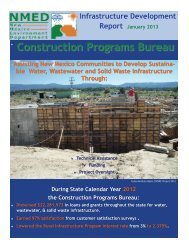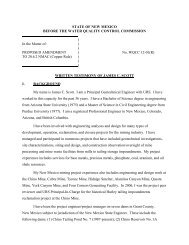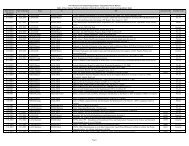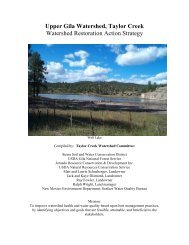Jarosa BMP Manual - New Mexico Environment Department
Jarosa BMP Manual - New Mexico Environment Department
Jarosa BMP Manual - New Mexico Environment Department
Create successful ePaper yourself
Turn your PDF publications into a flip-book with our unique Google optimized e-Paper software.
BEST MANAGEMENT PRACTICES<br />
FOR WATER QUALITY AND GRAZING ACTIVITIES<br />
ON THE R ANGELAND/J AROSA A LLOTMENT P ROJECT<br />
U NITED S TATES F OREST S ERVICE<br />
By Delbert Trujillo, <strong>Environment</strong>al Science Specialist<br />
WATERSHED PROTECTION SECTION<br />
S URFACE W ATER Q UALITY B UREAU<br />
NEW MEXICO ENVIRONMENT DEPARTMENT<br />
In Conjunction with the<br />
COYOTE RANGER DISTRICT<br />
S ANTA F E N ATIONAL F OREST<br />
SEPTEMBER 2002
Blank Page
Introduction<br />
JAROSA ALLOTMENT BEST MANAGEMENT PRACTICES<br />
By Delbert Trujillo<br />
The <strong>Jarosa</strong>/Rio Puerco de Chama Riparian-Rangeland Management Project was<br />
established to reduce pollutants into the Rio Puerco de Chama, <strong>Jarosa</strong> Creek, and the Rito<br />
Redondo watersheds. This report shall explain the steps that were taken to protect and<br />
improve water quality in the <strong>Jarosa</strong> allotment. Since grazing is a primary source of<br />
activity in the allotment various structures or Best Management Practices (<strong>BMP</strong>s) were<br />
introduced to alleviate the grazing pressures in the allotment.<br />
Location/Activity<br />
The <strong>Jarosa</strong> Allotment Project is located in the Santa Fe National Forest Coyote Ranger<br />
District, Coyote, <strong>New</strong> <strong>Mexico</strong>. The <strong>Jarosa</strong> grazing allotment encompasses the headwaters<br />
of the Rio Puerco de Chama and the upper portions of <strong>Jarosa</strong> Creek and the Rito<br />
Rendondo watersheds. Thirteen permittees from six families graze 343 head of cattle on<br />
this allotment. This allotment has used season-long grazing system on one pasture. Cattle<br />
are placed on the allotment in the spring and collected in the fall with little or no active<br />
livestock movement. This practice has resulted in the concentration of livestock and<br />
subsequent over-utilization of the riparian areas of the Rio Puerco de Chama, Rito<br />
Rendondo, and the wet meadows associated with <strong>Jarosa</strong> Creek. These areas make up a<br />
small percentage of the allotment, but incur the majority use. The allotment contains<br />
many mesas, slopes and uplands that produce good forage, but lack of water prevents<br />
utilization of these areas. To allow riparian areas and wet meadows to recover, a<br />
rotational grazing system must be developed. This development includes dividing the<br />
allotment into five pastures for rotation, construction of riparian protection fences, and<br />
most importantly the development of water sources in the uplands (Information from<br />
Project Proposal, USDA Coyote Ranger District).<br />
The drought of 1996 and 2002 has taken a heavy toll on the allotment. Although livestock<br />
numbers were reduced, the vegetation was severely stressed by the lack of precipitation.<br />
A rotational grazing system that allows grazed vegetation to rest is essential for recovery<br />
of the allotment. This type of system has been successfully used in other parts of the<br />
Coyote District with similar resource conflicts. This district implemented a rotational<br />
grazing system in the Rito Chihuahenos watershed. Riparian density and diversity<br />
increased as soon as cattle were exclosed from riparian areas. Upland forage quality and<br />
quantity improved when the rotation system was implemented.<br />
The Santa Fe National Forest Coyote Ranger District (SFNFCRD) and the <strong>New</strong> <strong>Mexico</strong><br />
<strong>Environment</strong> <strong>Department</strong>s Watershed Protection Section (WPS) have been working<br />
together in the improvements of water quality for the Rio Puerco de Chama, <strong>Jarosa</strong><br />
Creek, and Rito Redondo watersheds of the <strong>Jarosa</strong> allotment. The Coyote Ranger District<br />
1
applied and received a 319 (h) grant from the WPS to improve water quality and the<br />
riparian areas in the <strong>Jarosa</strong> allotment. The water quality improvements include divisional<br />
fencing (for rotational grazing), cattle guards, earthen dams, and trick tanks.<br />
Best Management Practices Implemented<br />
Trick Tanks<br />
Trick Tanks are structures that are naturally fed by rainwater or snow melt. Trick tanks<br />
should be located in grazing areas that have no access to water sources such as rivers,<br />
streams, or springs. Not only do trick tanks help in water containment and storage, but<br />
help alleviate grazing activities on riparian environments. By placing trick tanks in<br />
waterless grazing areas wildlife and livestock are diverted away from riparian areas<br />
thereby reducing degradation of riparian zones and improving water quality in<br />
watersheds by reducing impacts to streambank stabilization, turbidity, and bacteria. The<br />
benefits are: 1) Less pressure of grazing activities in riparian zones. 2) Diverting of<br />
wildlife and livestock to unused forage areas, due to lack of water sources. 3) Reduction<br />
of fire danger from piled dry grass. The possibilities for trick tanks are endless for<br />
grazing activities. The trick tanks can be located virtually anywhere in any range and<br />
grazing area. Trick Tanks can and may seem expensive, but in the long run the benefits<br />
out weigh the cost.<br />
This manual is intended to show those interested in grazing the benefits that will be<br />
gained using the trick tank implementation on the range. The photo documentation will<br />
address the process, which was used to implement the structures on the <strong>Jarosa</strong> Allotment<br />
of the Coyote Ranger District Santa Fe National Forest.<br />
2
Photo No. 1<br />
The preliminary stage of trick tank implementation is to clear and level the ground in<br />
which the trick tank structure will be located. Preparation will take into<br />
consideration the size of the structure. In the <strong>Jarosa</strong> allotment, for example, a 10,000<br />
gallon containment structures was implemented. A crew went in leveled and<br />
prepped the site prior to structure implementation.<br />
3
Photo No. 2 Photo No. 3<br />
After leveling and prepping the site a circular ring one foot wider in diameter then the trick tank structure was imbedded into<br />
the ground where the trick tank will be located. The imbedded ring is then filled with 3/4 inch size gravel. The imbedded ring<br />
should be 8 inches deep inside the ring; the crew then spreads gravel evenly inside the ring with a landscaping rake. The<br />
gravel is used as a venting system in an effort to eliminate moisture from settling underneath the trick tank structure. This<br />
reduces the rusting action associated with metal corrosion.<br />
4
Photo No. 4 Photo No. 5<br />
The trick tanks placed on the <strong>Jarosa</strong> were transported by a one ton rig and a goose neck trailer, as noted in photo no. 4 the<br />
structure is a half unit that will be welded together at the project site. Since the unit is 10,000 gallons it is virtually<br />
impossible to transport it as a single unit into the type of terrain that exists at the project site.<br />
Compare the size of the unit in photo no. 5 to the front-end loader. The front-end loader will unload the half unit and will<br />
transport it to the project site.<br />
5
Photo No 6 Photo No. 7<br />
The front-end loader will transport and place the two half units on the gravel ring (photo no. 6). After the two halves are<br />
conjoined or welded together the front-end loader makes adjustments to make sure that the unit is stabilized. The welds will<br />
be checked for leaks and appropriate measures will be taken if the welds are breached. The welded areas are coated and<br />
painted to maximize life expectancy of the structure (photo 7).<br />
6
Photo No 8<br />
Trick tank should be located and placed at a higher elevation then the trough system.<br />
This will be discussed later in this report at the Powder River trough systems.<br />
(See photo no. 18)<br />
7
Photo No 9 Photo No. 10<br />
4x4x8 treated wooden poles were placed vertically to hold the roof in place for the trick tank structures. 2x6x10 wooden<br />
planks were used for the roof. The roof was dropped a foot in the center of the structure so that rainwater and snowmelt<br />
enters the structure by gravity flow. 10x3 corrugated steel sheeting was placed over the 2x6x10 to deliver the water source<br />
into the trick tank.<br />
8
Photo No. 11 Photo No. 12<br />
The 4x4x8 beams had to be cut in various custom sizes to drop the roof into the center of the structure. The beams and<br />
planks were tied to each other with nails and bolts inside the trick tank. No specifications were retrieved from USDA Forest<br />
Service regarding this structure. Since in reality trick tanks can be of differing sizes discretion is up to builder on type of<br />
anchoring for the roof. Note photos 11&12 and how the planks and beams have been tied in to ensure solid non-moveable<br />
structure.<br />
9
Photo No. 13<br />
The finished roof drops into the trick tank and a sheet metal channel has been added in<br />
the center to ensure that all water flowing from the roof enters the structure. It is<br />
important to remember that every last drop of runoff from the roof is important to<br />
harvest into the structure especially in these type of environments. The drought of<br />
2002 showed us the real importance of water in these areas.<br />
10
Photo No. 14<br />
11<br />
Photo 16<br />
Photo No. 15<br />
If you look at the photo you will see the drop of<br />
the roof into the center of the structure. Note:<br />
that half of the roof is finished while the other<br />
half shows the horizontal planks holding the<br />
soon to be roof. In the drop section or middle of<br />
the roof (photo 15) you can see the sheet metal<br />
channel structure diverting the flow into the trick<br />
tank.
Photo. No 17<br />
The troughs that are used on the <strong>Jarosa</strong> allotment are Powder River type troughs. These are<br />
used because of their high quality durability in harsh environments.<br />
12
Photo No. 18<br />
The Powder River troughs are located at a lower elevation because water flow is by gravity<br />
(see photo 18). Note, the trick tank in the background is located at a higher elevation. The<br />
water from the trick tank is fed by gravity.<br />
13
Photo No. 19 Photo No. 20<br />
The trough systems is stabilized by staking T-posts around the trough and securing it with tie wire. Troughs are placed on 4x4x10<br />
foot beams to protect them from rusting and from sinking into the ground. The trough system has a float unit that releases enough<br />
water to fill it and protects against overflow, similar to a toilet bowl system.<br />
14
Photo No. 21 Photo No. 22<br />
The trick tanks have been placed in areas that are isolated but not inconvenient to locate. These structures are well hidden and<br />
blend into the surrounding environment.<br />
15
Earthen Dam Structures<br />
These structures are usually constructed of soil by heavy equipment like bulldozers or front-end loaders. Earthen dams are usually constructed in<br />
ephemeral type watersheds. The purpose of the structure is to retain water in isolated and waterless areas. The amount of water in the dam depends on<br />
the size and the soil type. Sandy type soils do not retain large amounts of water for too long because of porosity, while clay type soils retain water a lot<br />
longer because of minimal porosity and less seepage. Evaporation of standing water is another loss that occurs with dam structures.<br />
Photo No. 23<br />
Photo No. 24<br />
Photo No. 25<br />
Photos 23, 24, and 25 are the typical type of the earthen dam structures that have<br />
been implemented on the <strong>Jarosa</strong> allotment. The soil type in this area contains a high amount of clay. Earthen dams will work<br />
better in wet seasons than in drought years. In some areas bentonite may be used to cap high seeping dams.<br />
16
Cross Fencing (for rotational grazing practices)<br />
Photo No. 26<br />
The <strong>Jarosa</strong> allotment has been cross-fenced for the purpose of rotational grazing. The<br />
rotation of cattle in the sectioned allotment helps heal and alleviate pressure from<br />
grazing activities throughout the allotment. Cross sectioning of the allotment helps<br />
grasses and forage grow a lot better than as a single unit grazing system as it was<br />
before <strong>BMP</strong> implementation in the <strong>Jarosa</strong> allotment.<br />
17
Cattleguards<br />
Cattleguards are essential because they eliminate the need of gates. Cattleguards act as safety net in that cattle stay in designated sectioned areas, while<br />
traffic and individuals eliminate the need to open and close gates, especially in public lands.<br />
Photo No. 27<br />
18<br />
Photo No. 28
Conclusion<br />
The Best Management Practices (<strong>BMP</strong>s) that have been introduced along with the Range<br />
Management Plan for the <strong>Jarosa</strong> allotment of the Coyote Ranger District will help improve<br />
water quality, improve grasses and forage, and will include the allotment permittees in the<br />
decision making process along side the forest service. The implementation of the trick tanks,<br />
earthen dams, cross-fencing, and cattlegaurds will help the <strong>Jarosa</strong> allotment and its<br />
environment in improving the way grazing management activities will be conducted along<br />
riparian and watershed areas.<br />
<strong>New</strong> <strong>Mexico</strong> has been in drought conditions since 1996, or possibly earlier. The <strong>Jarosa</strong><br />
allotment project should represent a model for water quality improvements in our national<br />
forests. These improvements have already generated positive results. For example, trick tanks<br />
in a two-day drizzling rainfall period-generated 6, 000 gallons of water into a 10,000 gallon<br />
structure. Secondly, grazing activities are being conducted in an area that never was utilized<br />
before because of the lack of water (verbal communication SFNFCRD). With the<br />
introduction of water in non-grazed areas the grazed areas and their riparian environments<br />
are getting a deserved rest. The introduction of water in these non-grazed areas have led to<br />
the rangeland use of forage and grasses that had never before been grazed. It is these kinds of<br />
innovative ideas that help solve problems, and the Coyote Ranger District is taking such<br />
action.<br />
19









